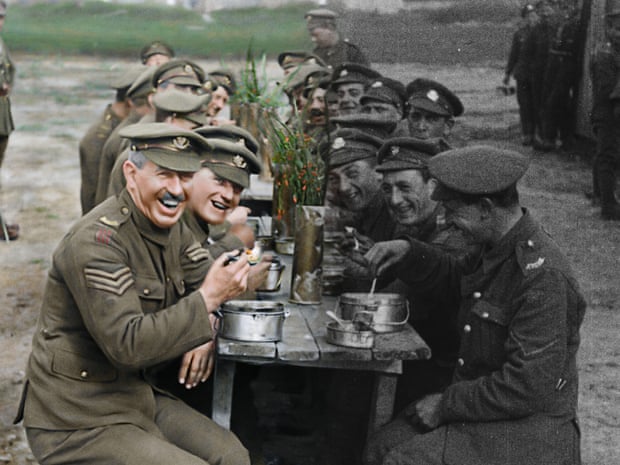Kyle Dent
A.S. Beat Reporter
Weaving together hundreds of Great War testimonials, an immersive soundscape, and re-textured footage, “They Shall Not Grow Old” revives a century-old conflict — compelling the viewer to confront how everyday people were forced to find light and hope in endless despair.
On Nov. 20, the Carsey-Wolf Center and the Pollock Theater featured a screening of “They Shall Not Grow Old” (2018), directed by Peter Jackson, filmmaker of several cult horror movies and “The Lord of the Rings” series. The documentary centers around the British soldiers of World War I, and uses decades-old interviews and footage from the United Kingdom’s Imperial War Museum.
Commissioned by said museum, 14-18 NOW, and the BBC, Jackson and his team set to create a film not about the important events of the war, or its political catalyst, but the soldiers themselves — without a narrator or any secondary voices, the story of the war and war life is completely told by veterans of the war interviewed in the ’50s and ’60s.
Recounting the war from when news broke out, to what it took for them to volunteer, to the trenches themselves, these veterans offer a beautiful tale, one created out of group consciousness — a forgotten, temporary culture that lasted only four years but involved hundreds of thousands of boys.
For example, many described the sheer amount of patriotism in Britain during the onset of the war, as well as the unrelenting need for bodies on the front lines. One interviewee described his attempt to get inducted into the military.
“I was still in school, and entered the office. I stepped up to the recruiting officer, told him my name, and that I was seventeen. He told me to leave, come back in, and tell him I was nineteen.” More voices then continued with similar stories, such as lying about their age, or getting turned away after first trying to apply when fifteen.
The entire story is told in a similar way; memories are recounted and unfolded piece by piece, interviewee by interviewee, slowly leading the story through the entire events of the war. The narration sounds almost like a recounting of war culture, and flows smoothly, never feeling “tugged” in an unnatural direction — it sounds more like friends reminiscing than a pieced-together voice track.
These boys are funny, too. I was surprised at the amount of levity in both the sound and film clips. Interviews are constantly making you chuckle, and even on the battlefield, nobody is taking everything 100% seriously, with some soldiers clunking their friend’s head with a tree trunk, and others laughing at a comrade who fell off a tank and face-first into mud.
You truly see the humanity in these soldiers, teenagers sent to kill — and the restored film works wonders in bringing that reality to the screen. Before the boys ship off, all footage remains in black and white, with choppy, vaudeville movement, and a square frame. However, as they step onto the field, the frame expands, color bleeds in, and you begin to see the war like they did.
The footage looks remarkably similar to any other old color film, and people’s skin, clothes, and blood become truly real on screen. While the colors themselves aren’t particularly astonishing (their surroundings are comprised of dirt, concrete, wood, and dry blood), their presence makes one realize how much they rely on color to believe the images they’re seeing on screen.
The visuals bring a new reality to this footage, but just as important (if not moreso) is the addition of synchronized sound effects and voices. This footage was all shot silently, but the film’s team recreated the soundscape of the battlefield — explosions burst loudly, low gunfire is constantly looming behind each shot, and several world-class lipreaders worked to recreate the silent dialogue.
The sound immerses you in the war — when a shell hits, you jump too. Soldiers mutter to one another about their living situation, and others bark orders when the fighting gets bad. Despite the audio being recreated, it never takes you out of the film. Every line fits every soldier’s mouth movements, and sounds of violence rattle you along with the men on screen.
These elements come together to tell a surprisingly modern-feeling story. The interviewees don’t sound like ancient relics, but real, living people, simply discussing their past. Many of them talked about the war as if it was simply an errand to run, a menial chore, their “duty.” You can see the effect that the first modern war had on the psyche of these unsuspecting teenagers, barely out of high school, still not fully grown.
“They Shall Not Grow Old” uses cutting-edge cinematic techniques, combined with the aid of century-old documentarians to demonstrate the resilience of humans undergoing trauma and to prove that we may truly be worth fighting for.












Great review, thanks!
Comments are closed.